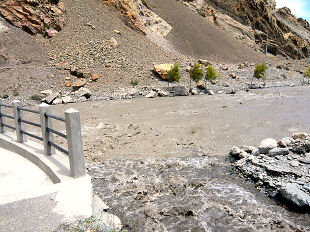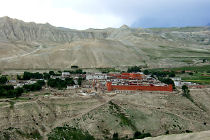
OM MANI PADME HUM |
||
ANNAPURNA CIRCUIT BASECAMP TREKKING Pokhara - Tatopani - Kagbeni - Jomson - Muktinath Śrī Muktināth Thīrthayātrī Sant Sevāśram, Kagbeni 2008 |
||
The Hidden Mystery of Kagbeni (Kagaveni) - Nepal 2013
Kagbeni or Kagaveni as it was known previously, is combination of two words, that is 'kag' means 'crow' and 'veni' means 'confluence of two rivers'.
At the confluence (veni) of the Krishnā-Gandaki and the Muktināth Kholā (a stream, Jhong Khola) lies the holy spot of Kāgbeni; the confluence spot which in ancient times was called Hamsatirtha. The etymology of Kāgbeni reflects this mystery: "kāga" or "Kāka" means "crow". The close by holy site is called as Kāgbeni-tirtha. The Hamsatirtha means literally "the holy spot of goose/ swan" itself.
According to the Puranas, this place has been named after the sage Kagabhusundi, who, born in the body of a crow, heard the story of Lord Rama from Garuda in his hermitage on Mahendracala mountain in Orissa. Here in Kagbeni he did penance, next to the hermitage of the 4 Kumaras.
Kagbeni, lies at the bank of Kali Gandaki River on the way to Muktinath few miles away from Jomsom. It is located at an elevation of 2,810 m, i.e., 939 m lower and 9.5 km west of Muktināth. This is renowned as a confluence of two rivers: Krishna Gandaki and Kaga Khola since meeting places of sacred rivers have great religious value in Hindu culture like Prayaga-Ganga, the confluence of Ganga and Jamuna, and Deva-Prayag, the confluence of Ganga, Jamuna and Alaknanda.
Gandaki River is called after Kagbeni Mustang Khola, and splits into 7 main streams up from the Lo Manthang area. The Stream coming from Damodar kund is considered the Krsna Ganga, also known as Salagrami Krsna Ganga (today known as Ghechang Khola in tibetan language) and forms the spiritual input on the Gandaki, as Lord Vishnu is worshipped as a Mountain next to the Damodar Kund, and from him the Salagrama Silas emerge. Practically speaking the whole area from Damodar kund up to lower region of Gandaki is impregnated with the Salagramas.
In Kagbeni a major tributary named Johng Khola, Kak Khola or Krishnā descends from Muktināth and joins the Kali-gandhaki.
Here you have a Sri Vaishnava Dharamshala for sadhus and pilgrims, the Śrī Muktināth Thīrthayātrī Sant Sevāśram, to stay and get free food, with a Shrine of 108 Shalagram-Shilas.
Kagbeni is also considered very sacred for Pitri-Puja as it is called Pitri-moksastala (where you deliver the ancestors from hell or give them the way for Liberation).
One who performs Pitri Shradda (a rite performed to commemorate the death of the elders’ esp. parents) near Kagaveni can easily facilitate the dead towards redemption. The value of Shradda at this place is many times more prominent than that at Gaya.
Kāgbeni is therefore especially important for Hindus to perform the final shraddha ceremony (ancestral rites) for the departed. These rites are commonly performed eleven days after the death of a parent, for example, and every eleven years thereafter. A shraddha performed during pilgrimage at the sacred confluence of two rivers is especially auspicious. Many pilgrims stop at Kāgbeni, usually the day before arriving at Muktināth, to perform the final rites for the departed, after which they are absolved from further obsequies duties.
In The Puranas Kagbeni is also known as Yakshya-Tirtha, because Nalakuvera und Manigriva, the two sons of the demigod Kuvera (known as Yakshya) passed through Kagbeni on their pilgrimage to Muktinath. (The Story of Nalakuvara and Manigriva)
In Kagbeni is also the last stop were we meet with the officials from the Nepali Goverment to check our trekking-permit for entering Upper Mustang or the "forbidden kingdom of Lo Manthang".
Kagbeni Checkpost for Trekking-Permit, to enter upper Mustang area


